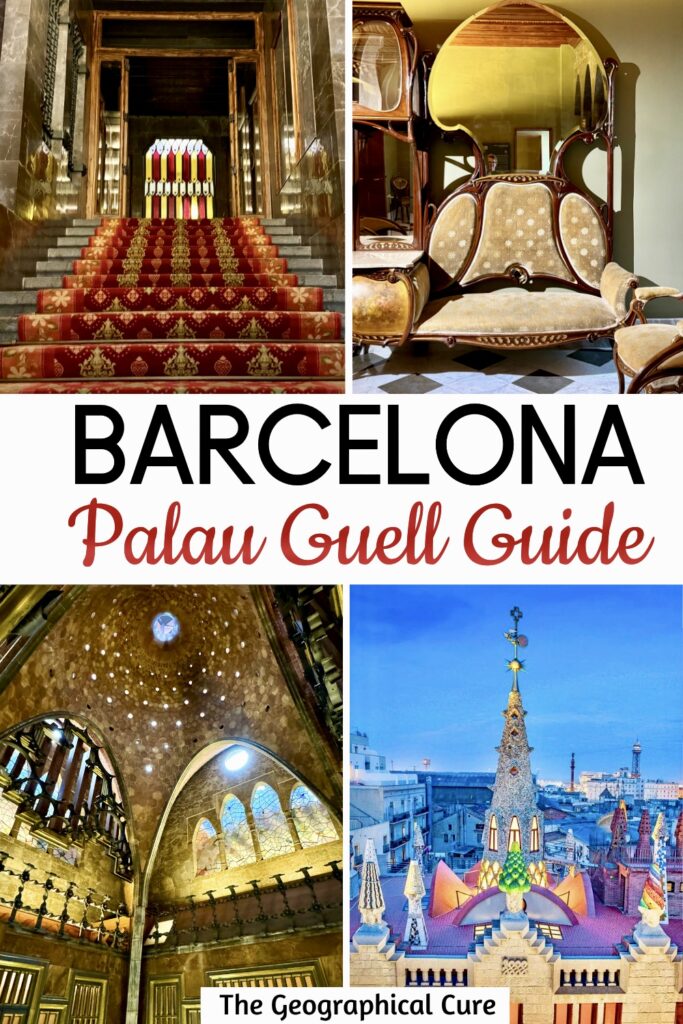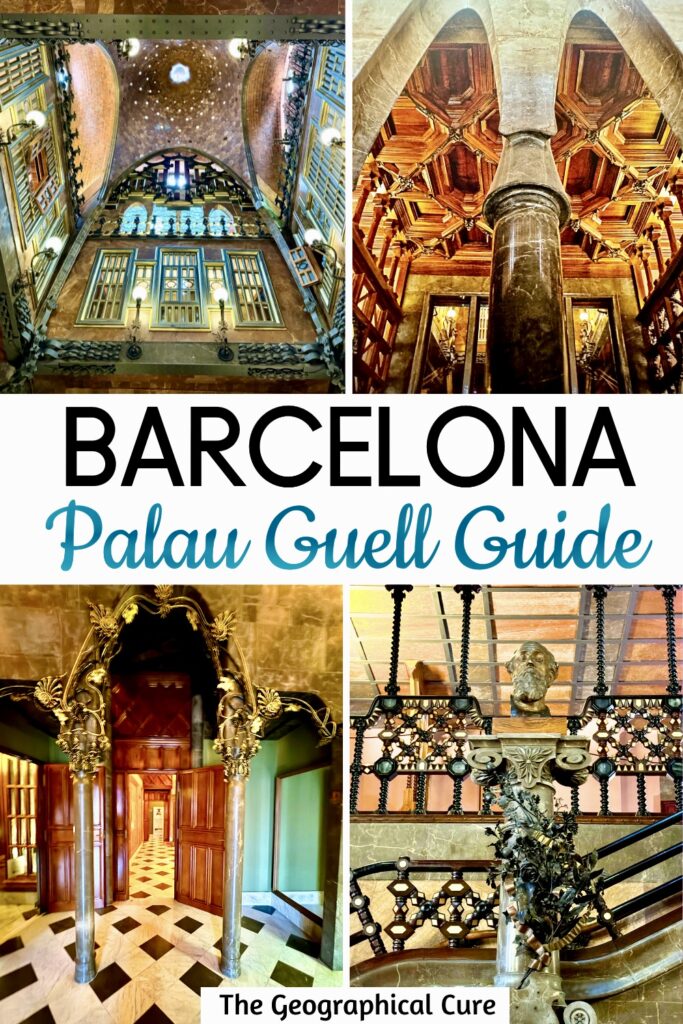One of Gaudi’s early masterpieces is just off La Rambla. But without the sign pointing the way, you might not even know it’s there!
Eusebi Güell (pronoucned g-WAY), Gaudi’s chief patron, commissioned the building in the 1880s. It was Gaudi’s first big project.
The palace is quite different and less flashy than Gaudi’s later, and more famous buildings, like Casa Batllo.
This building is situated in the oldest part of the city, combining past and present. There are traditional Gothic and Moorish designs, alongside Gaudi’s newly emerging Modernist take.
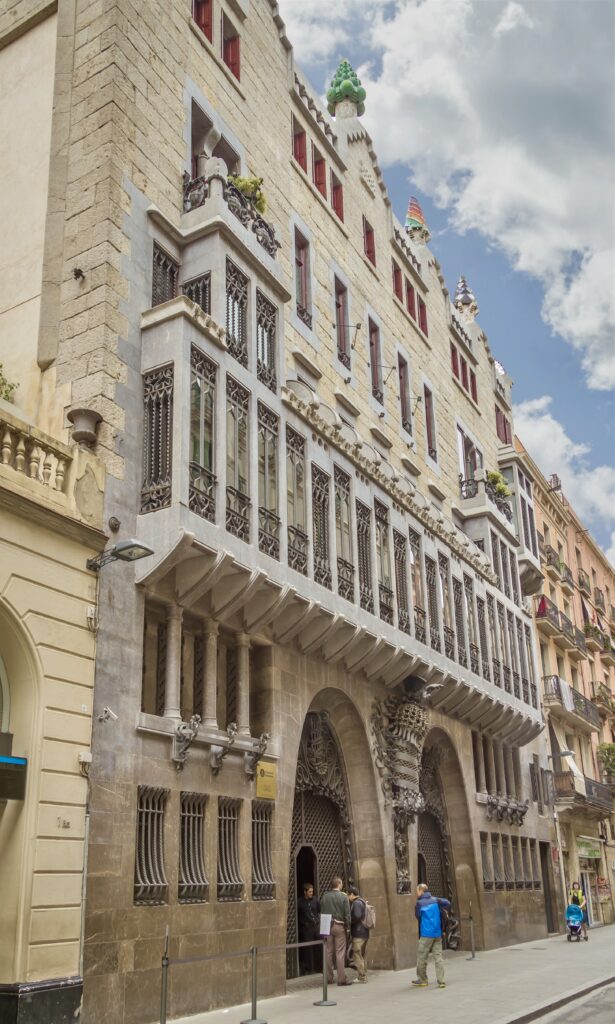
I think the palace exudes a sensuality and darkness, akin to a luxurious Venetian Renaissance palace.
Except on the loopy roof, where colorful chimneys abound.
In 1985, the building became a UNESCO site. In this guide to Palau Güell, I tell you everything to see and give you tips for visiting.
Quick Tips:
- there are 4 floors, 20 rooms, a basement, and roof to explore
- except in winter, you should pre-book a ticket to avoid lines
- pick up the audio guide, which is included in the price
- if it’s raining, the rooftop and basement will likely be closed
- plan to spend 1.5 to 2 hours visiting
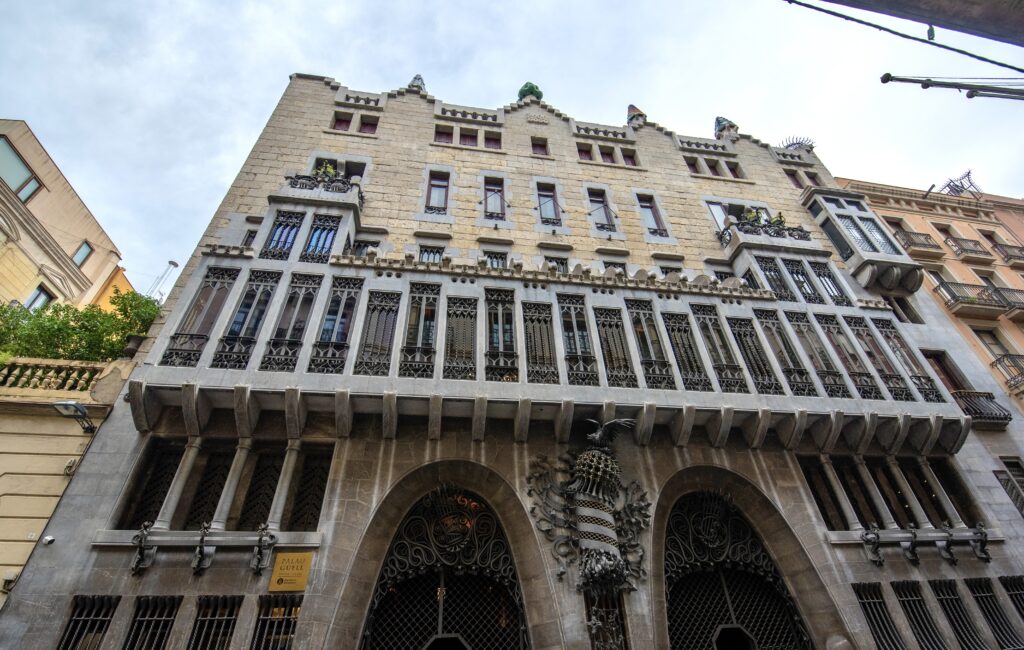
Guide To Palau Güell: What To See
With full creative liberty, Gaudi combined imaginative decor with a rationalistic use of space. The Güells had a busy social life, so they needed both private and public spaces.
Thoughout the palace, you’ll see the Gaudi used a diverse range of materials — ceramics, stone, wrought iron, and glass in the palace’s decoration.
The detail is astounding. Everywhere you look their are intricate decorative touches and applied art.
Red and brown colors predominate. And there are plenty of references to nature (flora, fauna, and animals), which was Gaudi’s sacred and driving source of inspiration.
Here are the must see palace highlights, which made my jaw drop.
Facade
Before you walk in, take in the facade. It’s quite monumental and austere. Güell wanted it that way to fit in with the look of the old city.
Gaudi kept it fairly classical. But he also used a dynamic treatment of volumes adding horizontal galleries and balconies.
Your real first clue that is is not your typical city palace are the two doors with parabolic arches. They are an exquisite work of art in wrought iron.
The iron work at the top simulates the body of two snakes, which supported by floral motifs.
Between the doors is a fantastical piece of wrought iron sculpture. At the top is a rather hostile looking eagle, the guardian of the palace.
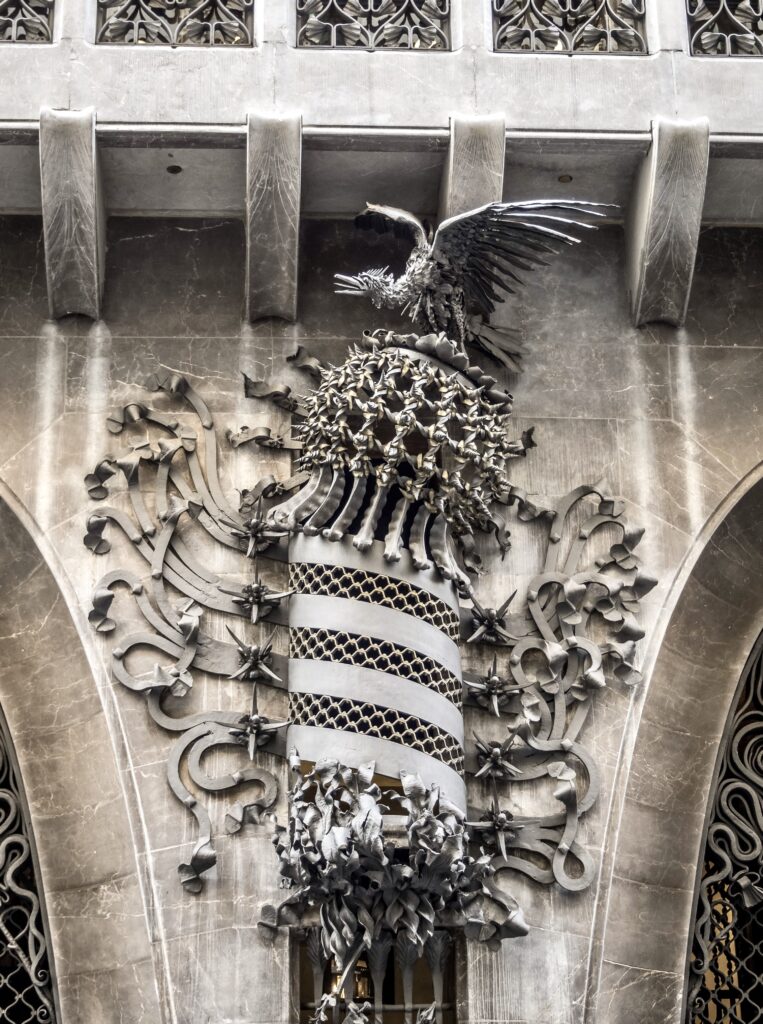
He stands on a helmet and the Catalan flag. Studded ribbons attach it to the wall.
The doors were ingeniously crafted to afford the Güells a view outward and welcome natural light inside. In contrast, the outside world couldn’t peak in, maintaining their privacy.
The rear facade is fairly restrained. Two large windows let in light to the main floor.
The only real decoration is the elaborate wooden and ceramic gallery that juts out. The lower, grilled part was used for the smoking room and as a base for Güell’s bedroom balcony.
You can’t walk around to see the rear facade. But you can admire it from the terrace.
Basement
The audio guide lead you first down a ramp to the stables below ground level.
This is where Gaudí’s experimentation comes to life. You can see his early fascination with incorporating organic forms.
There’s a bizarre landscape of mushroom-shaped capitals made entirely of brick.
You’ll see four rings on the floor where horses were tied up. Two have unicorn heads and two have dog heads.
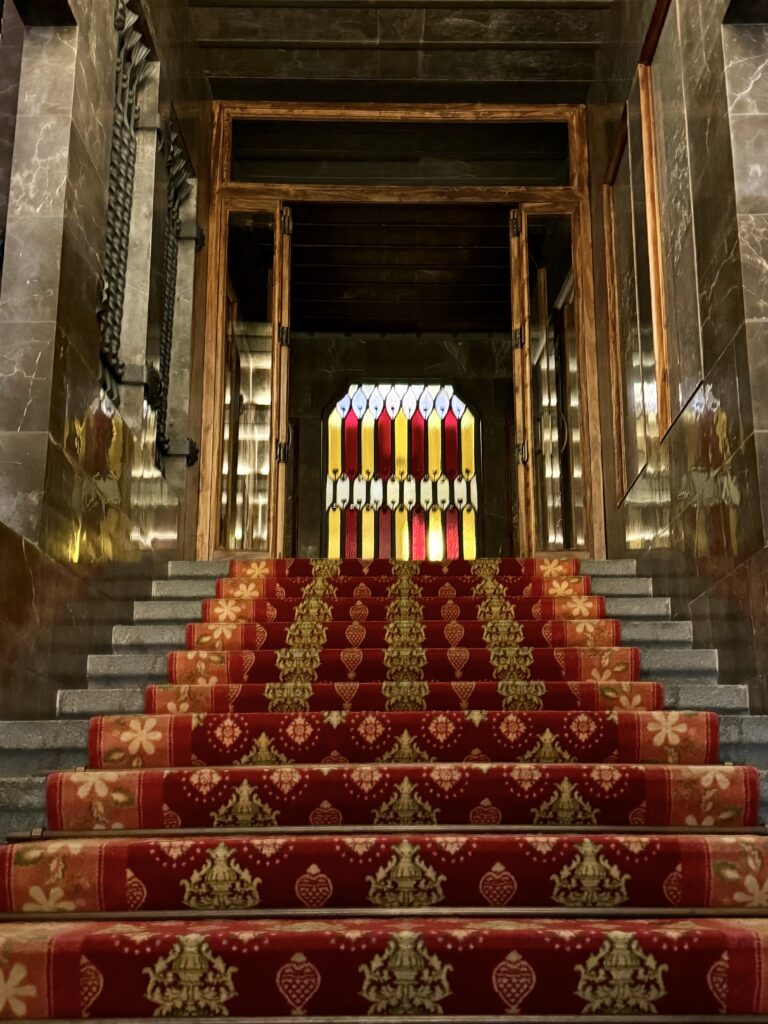
Vestibule
A spiral ramp leads you back up to the airy two story vestibule. It’s a double vestibule really, mimicking the two wrought iron entry doors.
The pavements looks like it’s made of bricks. But it’s actually red pinewood, a material which deadened the clatter of horses’ hooves.
The walls are in unclad brick, with extensive use of wrought iron.
In the back is the Carraige Room, where carraiges were deposited and horses led downstairs to the basement.
Grand Stairway
The staircase is in the middle of the vestibule. It’s made of a grayish stone from the Pyrenees. It’s flanked by rows of geometric columns in the stone.
Once you’re upstairs, the decor is luxurious not just functional.
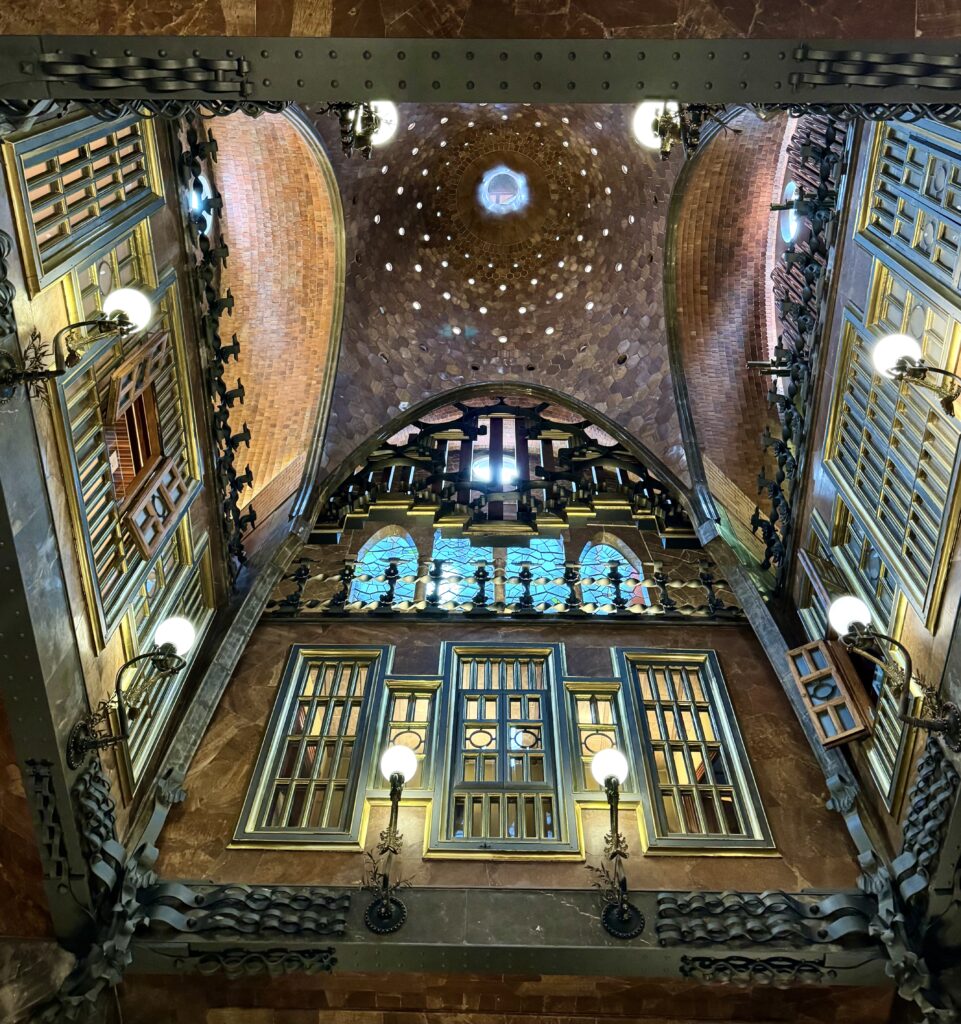
Central Hall
This monumental space is the heart of the palace and simply stunning.
From a square base, four parabolic arches soar three stories high.They end in a dome, over 50 feet from the floor.
I had the sensation of being in a small cathedral.
The salon is show-offy space, intended to announce the Guells’ social standing. This is where the Guell family held parties, celebrations, and political meetings.
Around this central room are the rest of the rooms on the main floor. Each has a unique function according to what social event would take place there.
The walls are clad in marble and alabaster. The cupola is covered with hexagonal pieces of translucent limestone. They get smaller as they approach the centeral oculus.
There are small holes near the top where lanterns were installed. That gave the appearance of a starry nighttime sky.
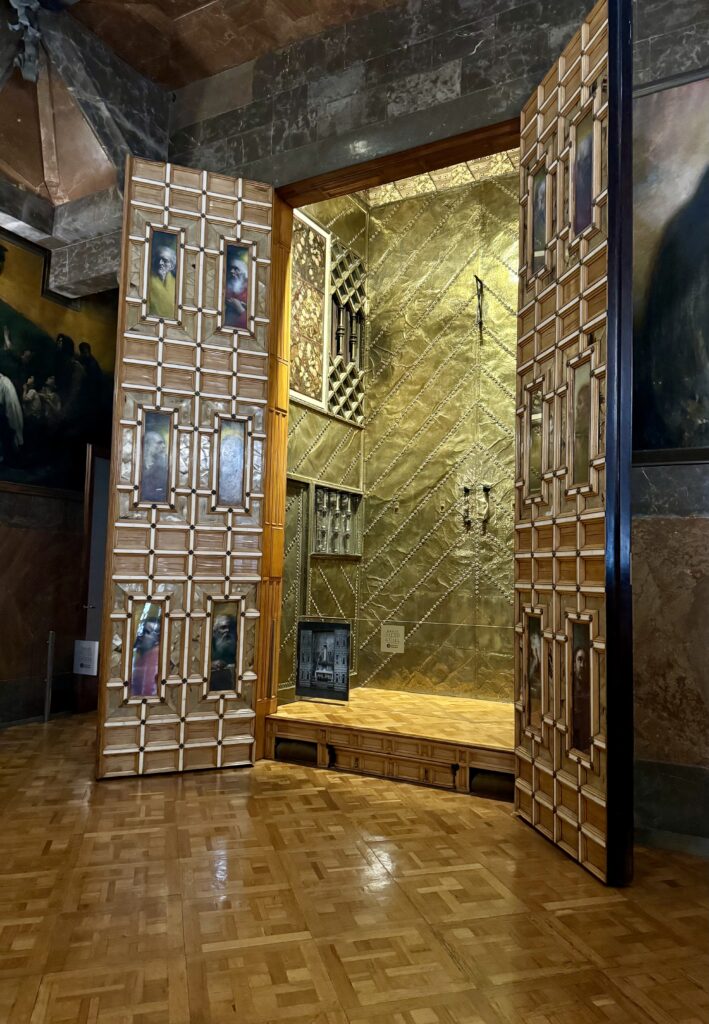
Chapel
Behind two hidden doors, a recessed chapel opens onto the Central Hall. It was used for religious events.
The doors are emblazoned with marquetry and 24 panels depicting apostles and saints painted by Aleix Clapes.
The chapel’s interior is entirely golden. It has a coffered ceiling and is decorated with tiny rosettes on diagonal lines.
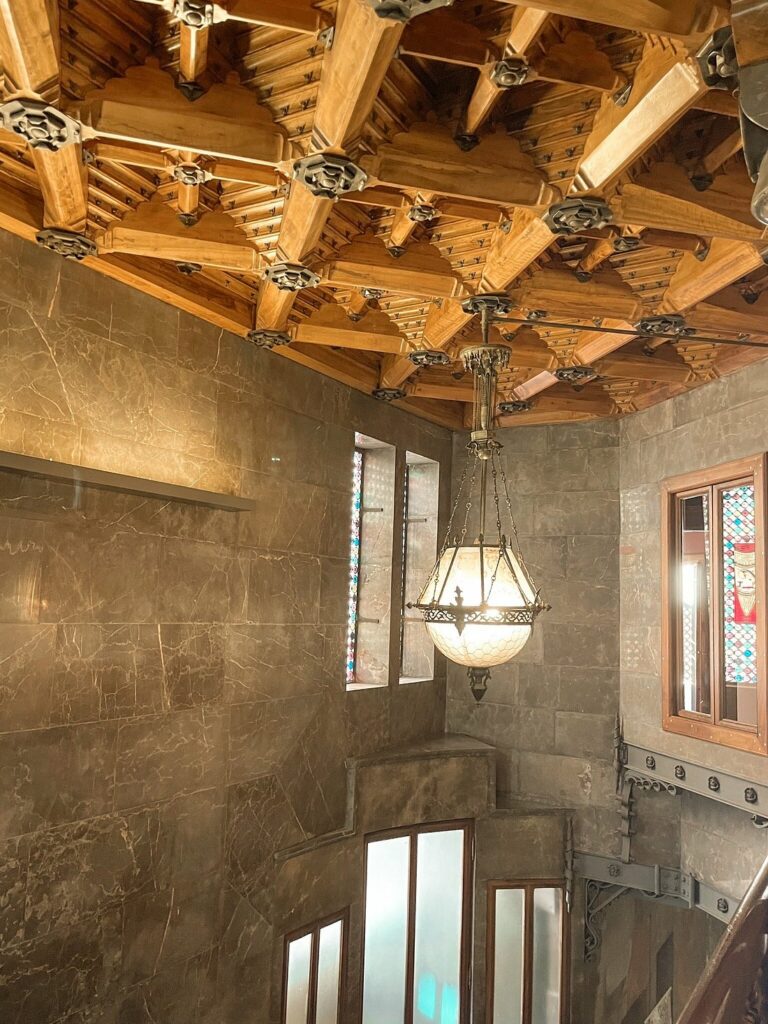
Antechamber
The grand stairway leads you up to the main floor of the house.
You’ll find antechamber that looks out onto the street and screens off the main salon.
There is an abundance of wrought iron, especially in the lamps. The coffered ceilings are also magnificent constructions of tropical timber and iron.
You’ll also see a wooden bench that Gaudi designed, which functions as a bannister. And stained glass windows decorated with Shakespeare characters.
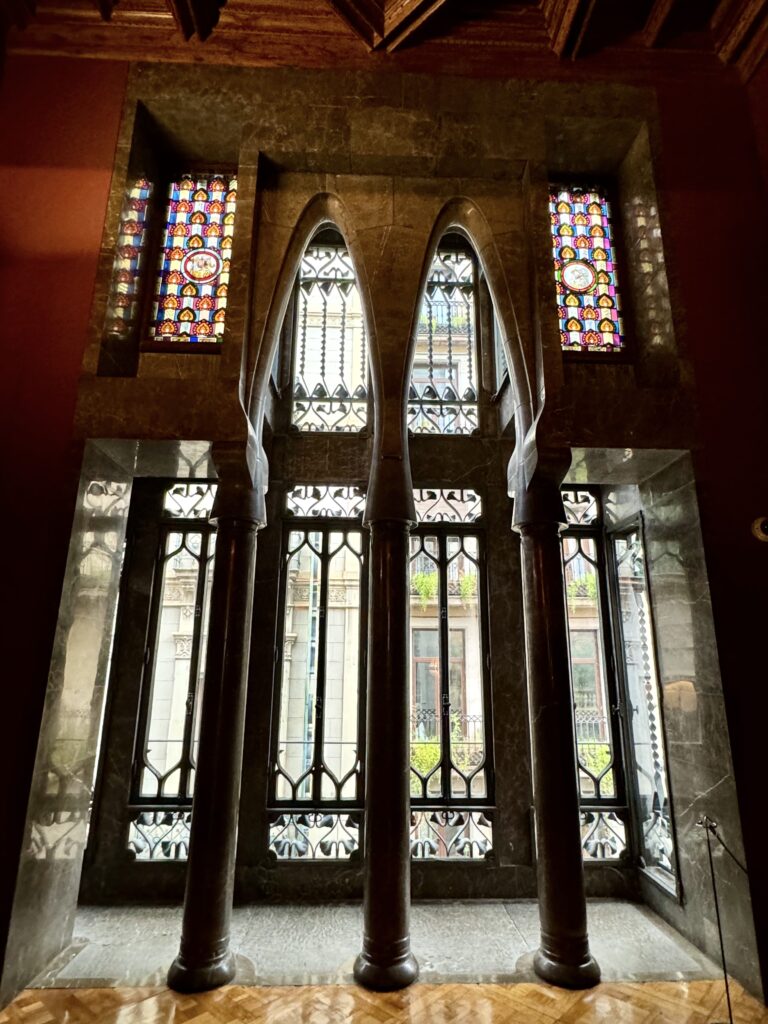
Parlor
The anteroom provides access to the Parlor. This was a space for private family gatherings and domestic activities.
It’s a large narrow space overlooking the courtyard in the back of the house.
There are more caternary arches in the gallery and the usual coffered ceilng with iron rosettes at the intersections.
In the adjacent Smoking Room, there is beauitful acid engraved glass surrounded by stained glass of flora and fauna.
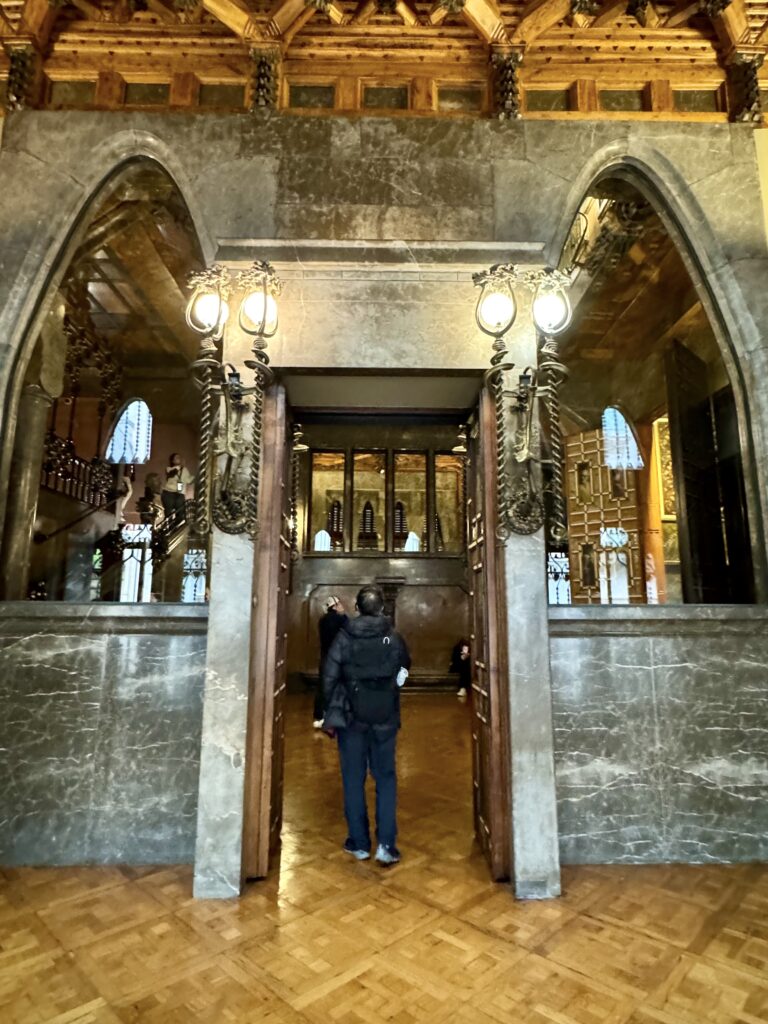
Room of the Last Steps
This is a beautiful room, a sort of passsageway for Guell’s guests before they arrived at the central hall.
Thre are esentially three facades, a trick of architecture that gives a luxury and dynamism to the room.
Two large caternary arches are one “facade.” Behind them, is a row of interior columns. And, then, finally, the grilled gallery over the street.
The coffered ceiling is another beauty, based on staggered and upside down pyramids. They are fitted into a grid of small and large squares.
Two vertical wrought iron lamps mark the entrance to the Central Hall. The frame juts out to give it a touch of monumentality.
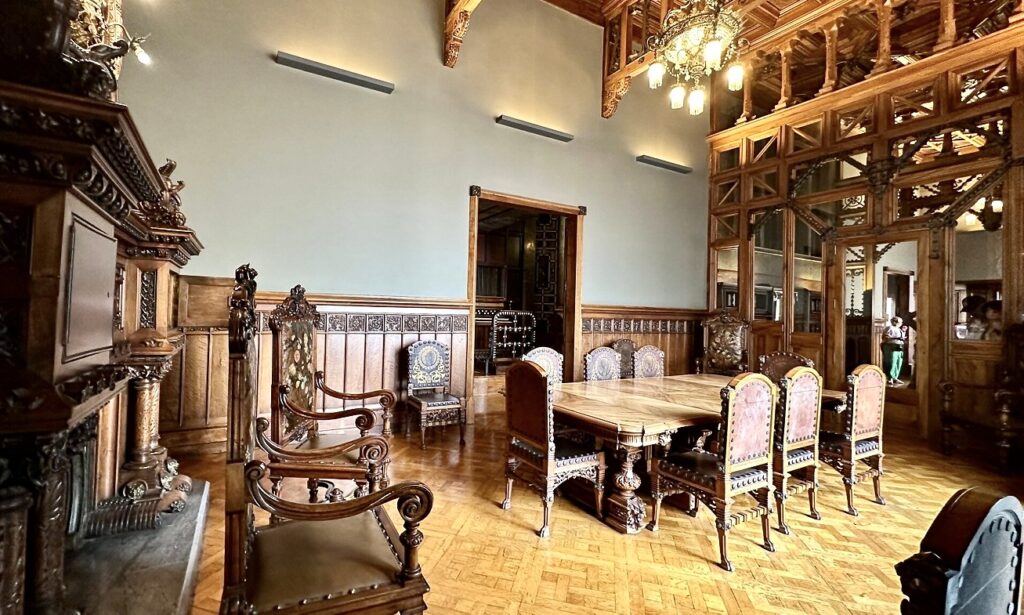
Dining Room
From the salon, a passage leads to the dining room. It’s a sumptuous affair of walnut paneling, heavy furniture, and carved wainscotting.
The room is presided over by a monumental marble and walnut chimney. It’s decorated with reliefs, including a lion’s head.
The wainscotting has a frieze decorated with delicate carvings. You’ll find flowers, birds, fish, and dragons.
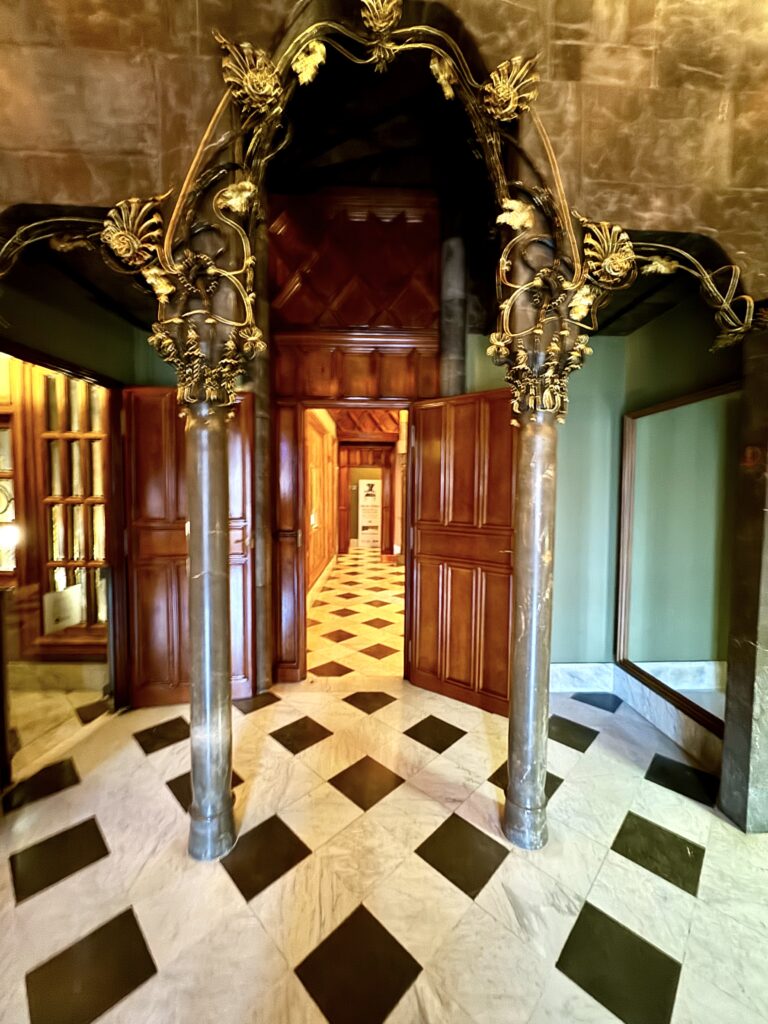
Second Floor
The second floor is the private palace and completely divorced from its other parts. This is the “bedroom floor.”
Apart from the grand Art Nouveau door to the parents’ bedrooms, this floor was more sparsely decorated.
The Master Bedroom is divided into two spaces, one for each spouse. This was the tradition for European high society of the day.
Eusbei’s bedroom has a series of stone columns and caternary arches. Isabel’s has arches decorated with Modernist garlands that hold medallions.
The bedrooms have wooden coffered ceilings, but they’re not terribly elaborate.
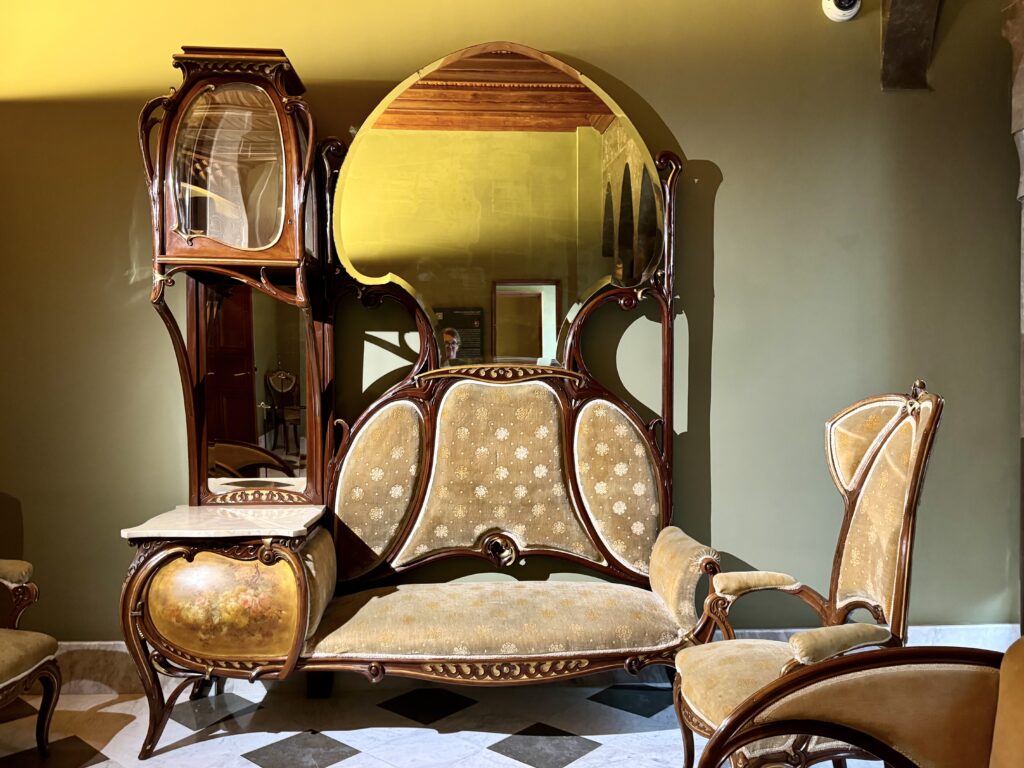
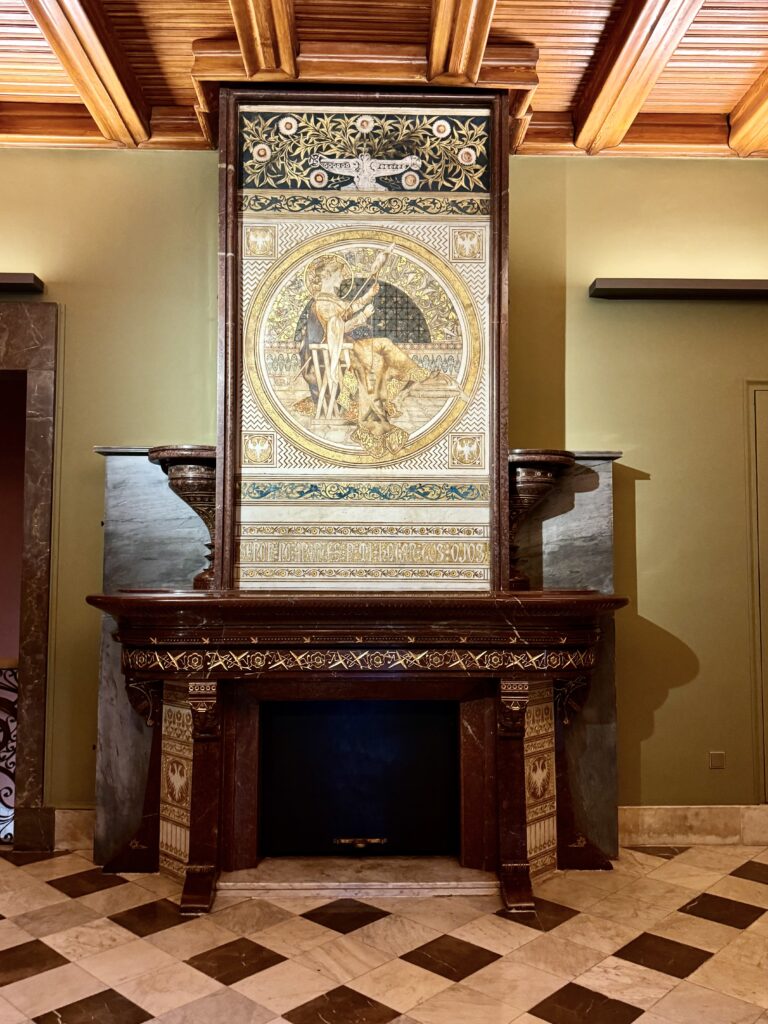
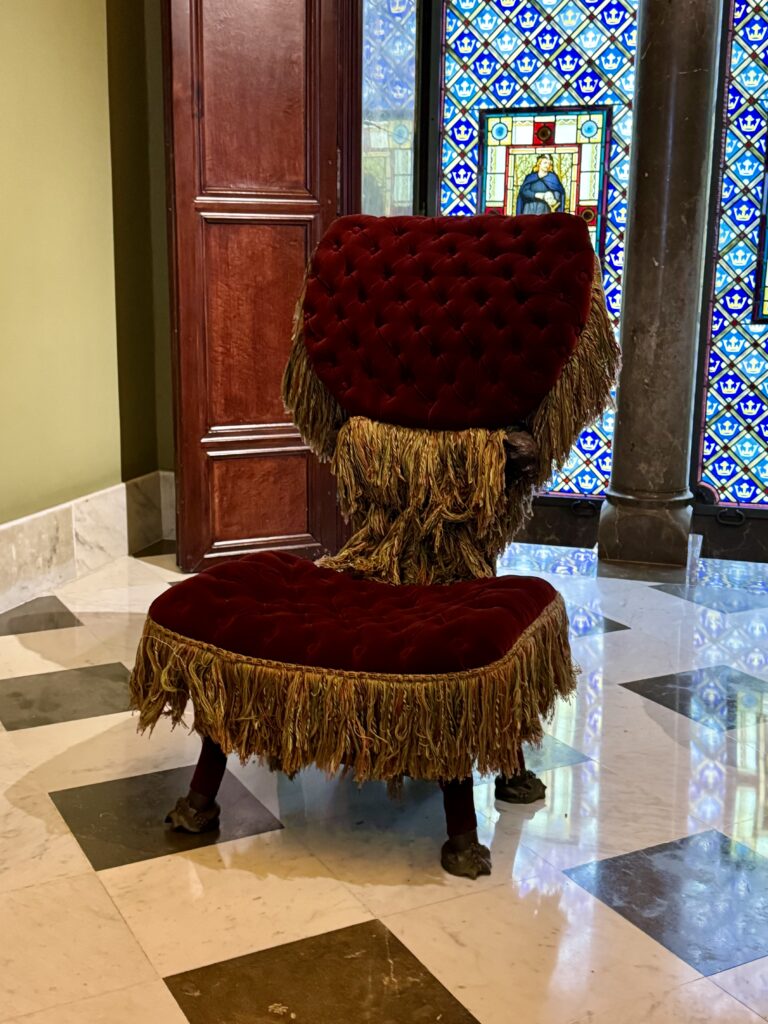
There’s some furniture on display in these rooms, some designed by Gaudi.
His famous “cat and mouse” chairs are there. Unlike much of his designs, they are upholstered in velvet and lavishly trimmed.
There was a parlor on the second floor set aside for family gatherings or meetings.
Windows overlook the Central Hall and you can peak through them. Spiraling steel bannisters separate the parlor and the last flight of stairs.
There’s a majestic chimney made of red marble and alabaster. There are plant shapes in a frieze over the hearth.
Above the mantle is a marble panel made by one of Güell’s favorite artists, Alexandre de Riquer. It depicts Queen Isabel of Hungary, who was the patron saint of Guell’s wife and daugher.
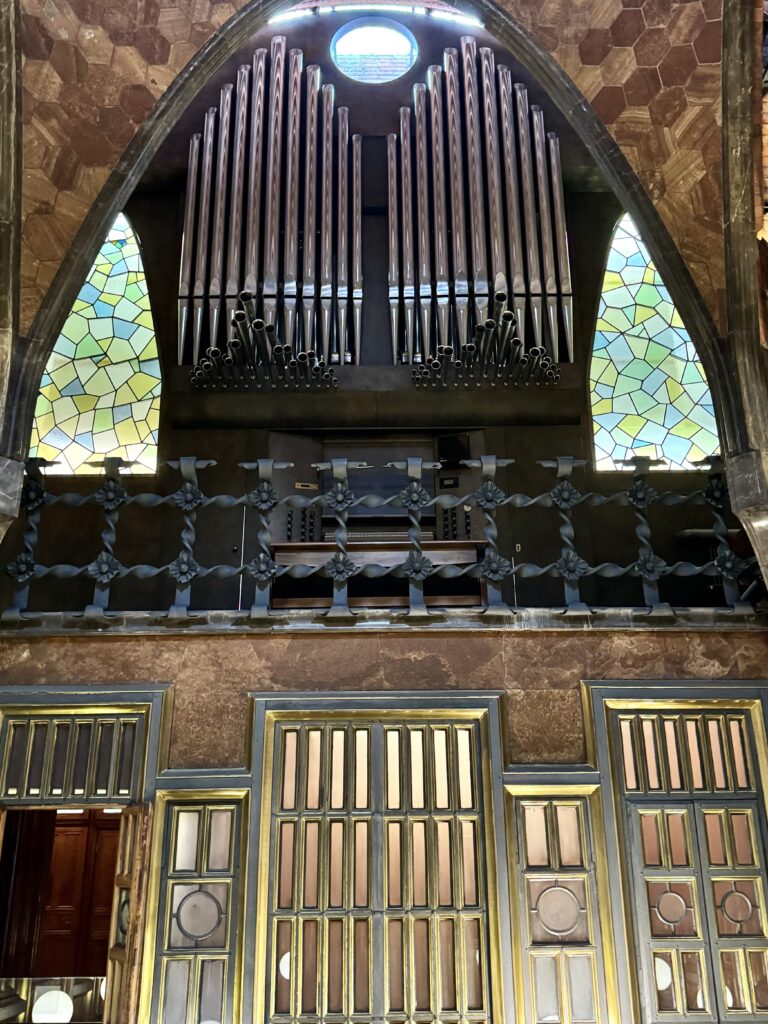
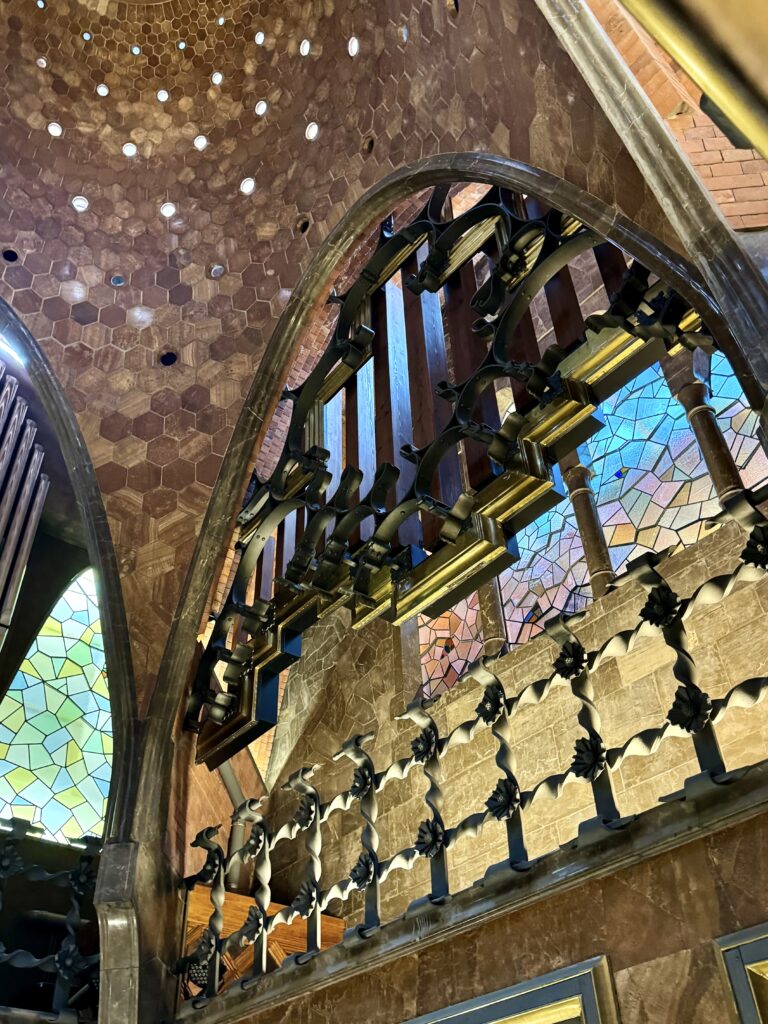
Upper Gallery
The Upper Gallery is the floor right above the bedrooms.
It has an organ made by the Basque organ maker Aquilino Amezua on Güell’s request. Gaudí designed its place in the building to perfectly mix music with the architecture.
The gallery also features blue and green “trencadis” ceramic pieces, which was one of Gaudí’s key style innovations.
Plus, there’s a wrought iron railing around the gallery decorated with spiraling columns and sunflower designs.
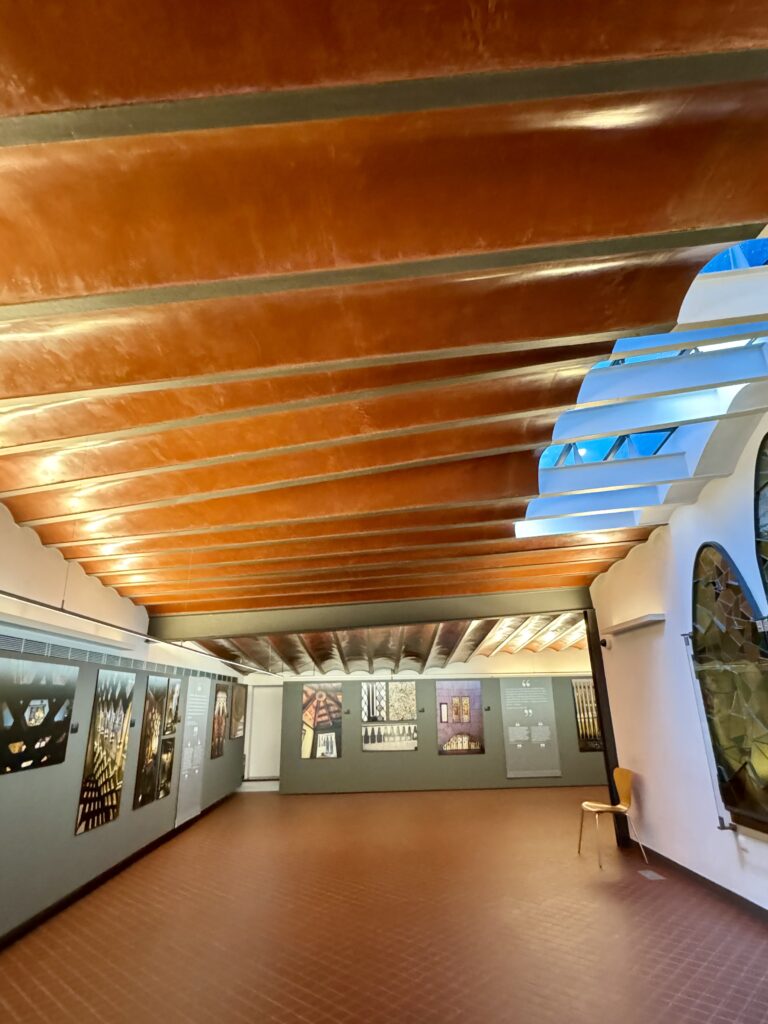
Attic
The attic was the service floor. This where the kitchen and laundry were located.
This utilitarian aspect of the attic is seamlessly integrated into the overall artistic vision, showcasing Gaudí’s ability to blend form and function.
This space is now used to exhibit art and photographs. You’ll also find a model of Palau Güell.
Rooftop
On the roof, Gaudi turned a traditionally forgotten area into a colorful chimney forest. It’s was a breakthrough that presaged his later fantastical roofs on Casa Batllo and La Pedrera.
He converted the chimneys into inventive universe of sculptural works. They’re clad in brick, sandstone, and colorful trencadis (fragments of broken tiles).
Its a stark, and magical, in contrast to the austerity of much of the palace.
The roof terrace is divided into four levels.
A central slender spire-lantern is surrounded by 20 different chimneys of all shapes and colors. It’s over 50 feet high. On the top is a lightning rod and a bat, the symbol of Catalonia.
Practical Guide & Tips For Palau Güell
Address: Carrer Nou de la Rambla 3-5. It’s on a side street and easily missed unless you’re searching for it.
Hours: Open Tuesday to Sunday from 10:00 am to 8:00 pm. In winter, the palace closes at 5:30 pm.
Tickets:
The ticket price is 12 euros. The ticket office is to the left of the entrance.
This is one of the less expensive Gaudi attractions. The audio guide is also included in the ticket price.
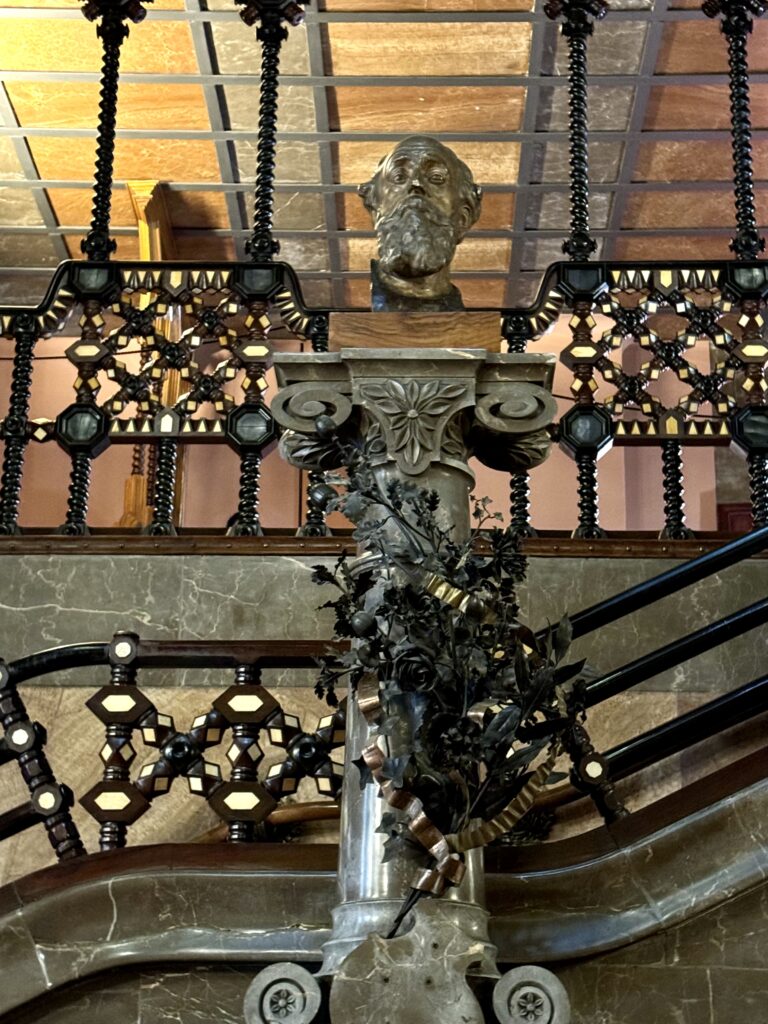
I would get it because it reveals key features of Gaudi’s techniques. And there’s very little signage in the palace.
You can also scan a QR code to download the audio guide on WiFi. If you prefer, you can always book a guided tour of the palace.
Pro Tips:
I would expect to spend about 1.5 to 2 hours at the palace. You’ll have to put any large bags or backpacks in a locker for 1 euro.
My pictures don’t do it justice. It’s a hard place to photograph because it’s dark inside.
There are quite a lot of stairs. But there is also an elevator.
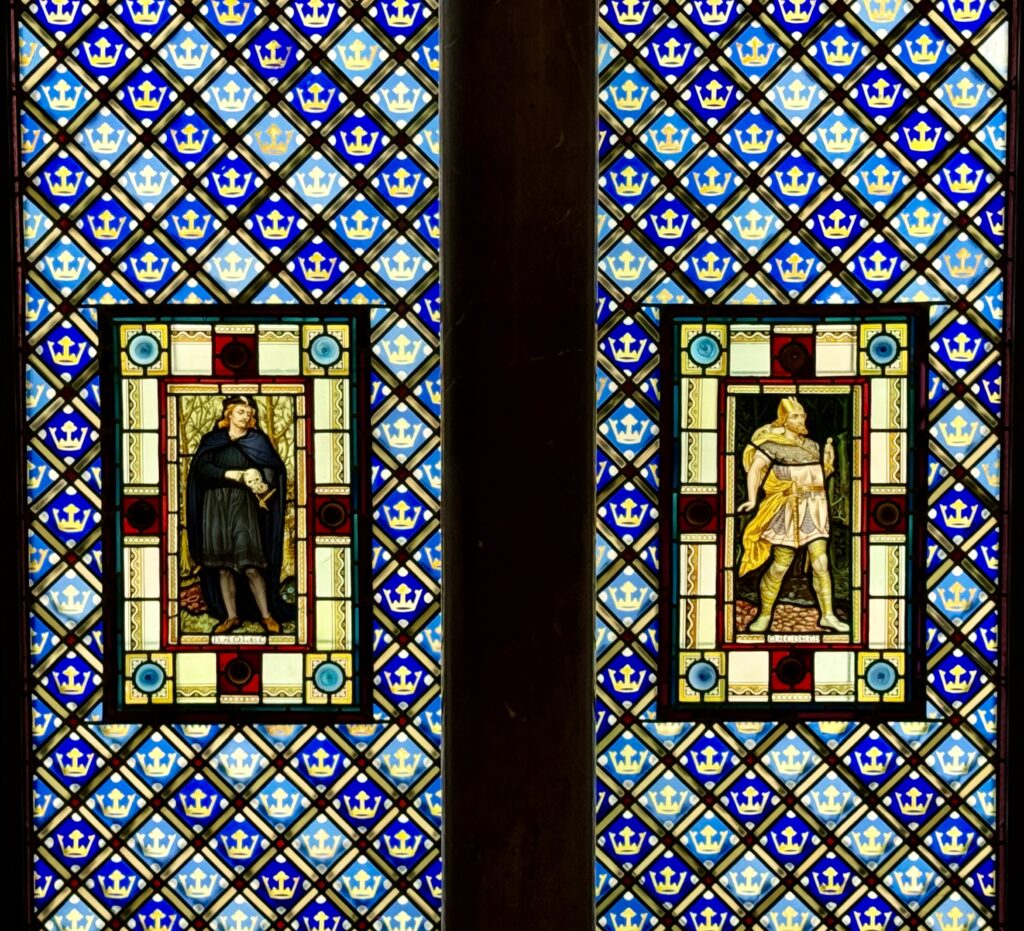
Is Palau Güell Worth Visiting?
For me 100% yes. It was the first Gaudi palace that I visited and I think it makes sense to tour it before seeing Casa Batllo, La Pedrera, and Casa Vicens.
Honestly, I liked it almost as much. It’s got a more brooding Moorish vibe. But I found it fascinating and loved all the details. The interior seemed superior, in fact, than Casa Batllo to me.
I hope you’ve enjoyed my guide to Palau Güell. You may find these other Barcelona travel guides useful:
- 1 day in Barcelona itinerary
- 3 days in Barcelona itinerary
- what to do in the Gothic Quarter
- landmarks in Barcelona
- guide to Casa Batllo
- guide to La Pedrera
- guide to architecture in Eixample
Pin it for later.

